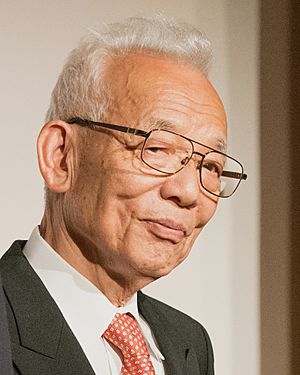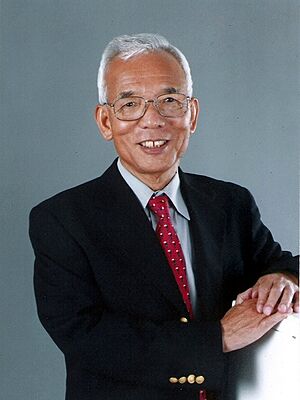Syukuro Manabe facts for kids
Quick facts for kids
Syukuro Manabe
|
|
|---|---|

Manabe in 2018
|
|
| Born | 21 September 1931 Shinritsu, Uma, Ehime, Japan
|
| Education | University of Tokyo (BA, MA, DSc) |
| Occupation | |
| Awards |
|
| Academic career | |
| Fields | Meteorology, climatology, climate change, computer simulation |
| Institutions | |
| Doctoral students | Isaac Held, Kenneth Bowman, Alex Hall |
Syukuro "Suki" Manabe, born on September 21, 1931, is a Japanese-American scientist. He is a physicist, a meteorologist (someone who studies weather), and a climatologist (someone who studies climate). He was one of the first scientists to use computers to create models of Earth's climate. These models helped predict climate change and understand natural climate shifts.
In 2021, Manabe won the Nobel Prize in Physics. He shared the award with Klaus Hasselmann and Giorgio Parisi. He was honored for his work on creating physical models of Earth's climate. His research helped us understand how much the climate changes and how to predict future climate changes.
Contents
Early Life and School
Syukuro Manabe was born in 1931 in a small village in Japan. His grandfather and father were both doctors. They ran the only clinic in their village. Even as a child, Manabe was very interested in the weather. A classmate remembered him saying that Japan would not have so much rain if it weren't for typhoons. Typhoons are powerful tropical storms.
Manabe went to Ehime Prefectural Mishima High School. When he was accepted into the University of Tokyo, his family hoped he would study medicine. However, Manabe felt he wouldn't be a good doctor. He said he had a bad memory and was clumsy. He believed his best quality was "to gaze at the sky and get lost in my thoughts." So, he decided to study meteorology, the science of weather. He earned three degrees from the University of Tokyo: a Bachelor of Arts in 1953, a Master of Arts in 1955, and a Doctor of Science in 1958.
Manabe's Career Journey
After finishing his studies, Manabe moved to the United States. He began working at the U.S. Weather Bureau. This organization is now known as the Geophysical Fluid Dynamics Laboratory (GFDL) of NOAA. NOAA stands for the National Oceanic and Atmospheric Administration. He worked there until 1997.
From 1997 to 2001, Manabe returned to Japan. He worked at the Frontier Research System for Global Change. There, he was the Director of the Global Warming Research Division. In 2002, he came back to the United States. He became a visiting researcher at Princeton University. He is currently a senior meteorologist at the university. He also worked as a special professor at Nagoya University in Japan from 2007 to 2014.
Amazing Scientific Discoveries
While working at NOAA's GFDL, Manabe helped create important computer models. These were some of the first three-dimensional models of Earth's atmosphere.
Understanding Temperature Changes
One of his first big steps was developing a simple model of the atmosphere. This model helped him and his colleague, Richard Wetherald, understand how the atmosphere heats up. They found that when the amount of carbon dioxide in the air increases, the temperature goes up near Earth's surface. This area is called the troposphere. However, the temperature actually goes down in the stratosphere, which is a higher layer of the atmosphere.
Modeling Earth's Climate
This simple model was very important for creating more complex climate models. Manabe and his team used these models to show how temperature and the hydrologic cycle (the movement of water on Earth) respond to more carbon dioxide. The hydrologic cycle includes things like evaporation, clouds, and rain.
In 1969, Manabe and Kirk Bryan made another huge step. They published the first computer simulations of climate using "coupled ocean-atmosphere models." This means they combined models of the atmosphere with models of the ocean. This allowed them to study how the ocean and atmosphere work together to create climate.
Predicting Future Climate
Throughout the 1990s and early 2000s, Manabe's team continued to use these models. They studied how climate changes over time when greenhouse gases increase. Greenhouse gases, like carbon dioxide, trap heat in the atmosphere. Their work helped predict how Earth's climate would change in the future.
They also used their models to study past climate changes. For example, they looked at how fresh water flowing into the North Atlantic Ocean might have caused sudden climate shifts in the past. These shifts are seen in ancient climate records.
Awards and Special Recognitions
Syukuro Manabe is a member of many important scientific groups. These include the United States National Academy of Sciences and the Royal Society of Canada.
He has received many awards for his groundbreaking work:
- In 1992, he was the first person to receive the Blue Planet Prize.
- In 1995, he received the Asahi Prize.
- In 1997, he was given the Volvo Environmental Prize.
- In 2015, he received the Benjamin Franklin Medal.
Manabe has also been honored by major scientific organizations. He received the Carl-Gustaf Rossby Research Medal and the William Bowie Medal. His work with Kirk Bryan on the first global climate models is considered one of the top ten breakthroughs in NOAA's history.
In 2016, Manabe shared the BBVA Foundation Frontiers of Knowledge Award with climatologist James Hansen. Both scientists created early computer models that could predict how much Earth's temperature would rise due to increasing carbon dioxide. The many climate models used today are based on their pioneering work.
In 2018, Manabe received the Crafoord Prize in Geosciences. He shared it with Susan Solomon. They were recognized for their important contributions to understanding how gases in the atmosphere affect Earth's climate. In 2021, he received the Order of Culture, a high honor in Japan. In 2022, he was named one of the "Great Immigrants" by the Carnegie Corporation of New York.
The Nobel Prize
In 2021, Syukuro Manabe was awarded half of the Nobel Prize in Physics. He shared it with Klaus Hasselmann. They were honored "for the physical modeling of Earth's climate, quantifying variability and reliably predicting global warming." This means their work helped us understand how Earth's climate works, how much it changes naturally, and how to predict future warming. Shuji Nakamura, another Nobel Prize winner from Manabe's home prefecture in Japan, congratulated him on this amazing achievement.
See also
 In Spanish: Syukuro Manabe para niños
In Spanish: Syukuro Manabe para niños
- List of Nobel laureates affiliated with the University of Tokyo
- List of Nobel laureates affiliated with Princeton University
- List of Japanese Nobel laureates
- List of Asian Nobel laureates
- List of Nobel laureates


